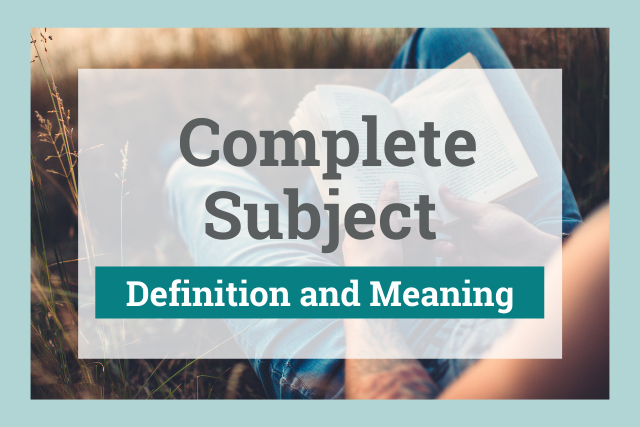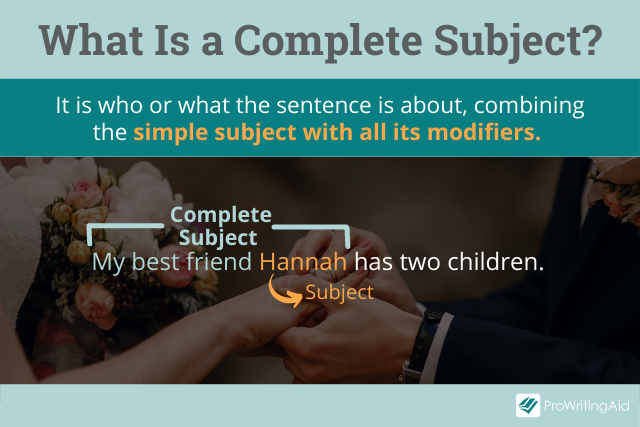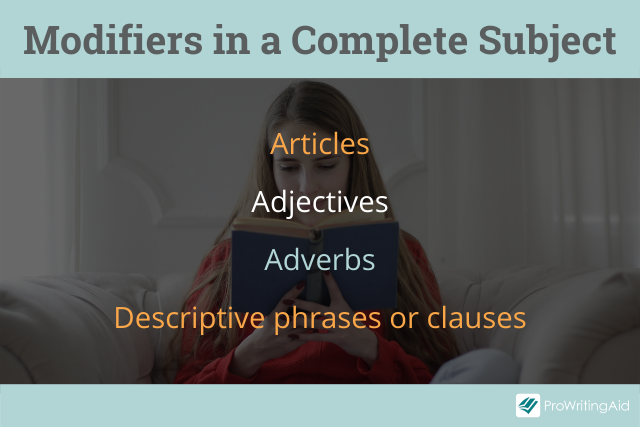
Every sentence has a subject and a predicate.
Subjects can be simple or complete. A complete subject tells us who or what the sentence is about, along with any extra information about the subject.
In this article, we will look at what a complete subject is and provide several examples.
What Is a Complete Subject?
To understand and define the complete subject, it’s important to understand what the subject and predicate are.
A subject is the part of a sentence that tells us who or what the sentence is about. A predicate is the part of a sentence with a verb—it’s what the subject is doing.

There are two types of subjects in sentences: simple and complete.
A simple subject is only the main word or words that “do” the verb. No extra information is included in a simple subject.
A complete subject, on the other hand, includes the main word or words and any modifiers.
Modifiers are words that add information or description to another word. They can include articles, adjectives, and adverbs. They can also include entire phrases or clauses.
Let’s see what modifiers look like in an example sentence:
- My best friend Hannah has two children.
The sentence is about Hannah. Hannah is the simple subject. The complete subject is “my best friend Hannah.”
Components of a Complete Subject

Let’s take a deeper look at the parts of a subject so you can easily identify the complete subject.
Complete subjects usually appear at the beginning of a sentence or clause, but not always.
The first step in identifying complete subjects is asking yourself who or what is doing the verb. If the verb is not an action verb, ask who or what the sentence is primarily talking about.
Now, let’s check out a detailed example:
- The beautiful painting she bought on vacation hung on the wall behind the sofa.
Before we can find the complete subject, we should find the simple subject and the predicate. The simple subject typically refers only to the main noun.
In this sentence, the simple subject is “painting.” Notice how this doesn’t include the article “the.”
Now, let’s identify the predicate so that we know which words comprise the complete subject.
The predicate is the part of the sentence that contains the main verb or verb phrase. In our example, the verb is “hung.” The complete predicate is “hung on the wall behind the sofa.”
That leaves us with the complete subject, “the beautiful painting she bought on vacation.”
It includes the simple subject, “painting,” and the modifiers “the” and “beautiful.” It also includes a restrictive clause, “she bought on vacation.”
Some sentences have a compound subject, which means there are two or more subjects that share the same verb. Together, all the simple subjects and their modifiers make a complete subject. Here’s how to find both the simple subject and the complete subject in this situation.
- The brown dog and the little boy played outside all day.
The conjunction “and” lets us know we’re dealing with a compound subject. Even though this sentence has a compound subject, we will use the same process. The simple subjects in this example are “dog” and “boy.” These are who the sentence is about.
Next, let’s find the verb. In this sentence, “played” is the verb. The complete predicate is “played outside all day.”
That leaves us with the complete subject, “The brown dog and the little boy.” The components of the complete subject in this example include articles, “the,” and adjectives, “brown” and “little.”
Complete Subject Examples List
Here are several more complete subject examples. In each sentence, locate the simple subject, the verb, and the complete predicate. This will help you find the complete subject.
- The new book I checked out from the library was so well written!
What is this sentence talking about? It’s talking about a new book. The simple subject is “book.” The verb “was” tells us where to find the predicate. This means that the complete subject is “The new book I checked out from the library.”
In the following examples, the complete subject is highlighted.
- My grandmother’s vintage stand mixer still works better than any new model.
- Lola, my daughter, loves to play with cars and trucks.
- The new high chair and the used stroller are both for sale.
- After class, the students who failed the test stayed behind to ask questions.
Remember, the complete subject represents all the information that modifies the simple subject. If you can identify the simple subject and the verb, finding the complete subject is easy.


